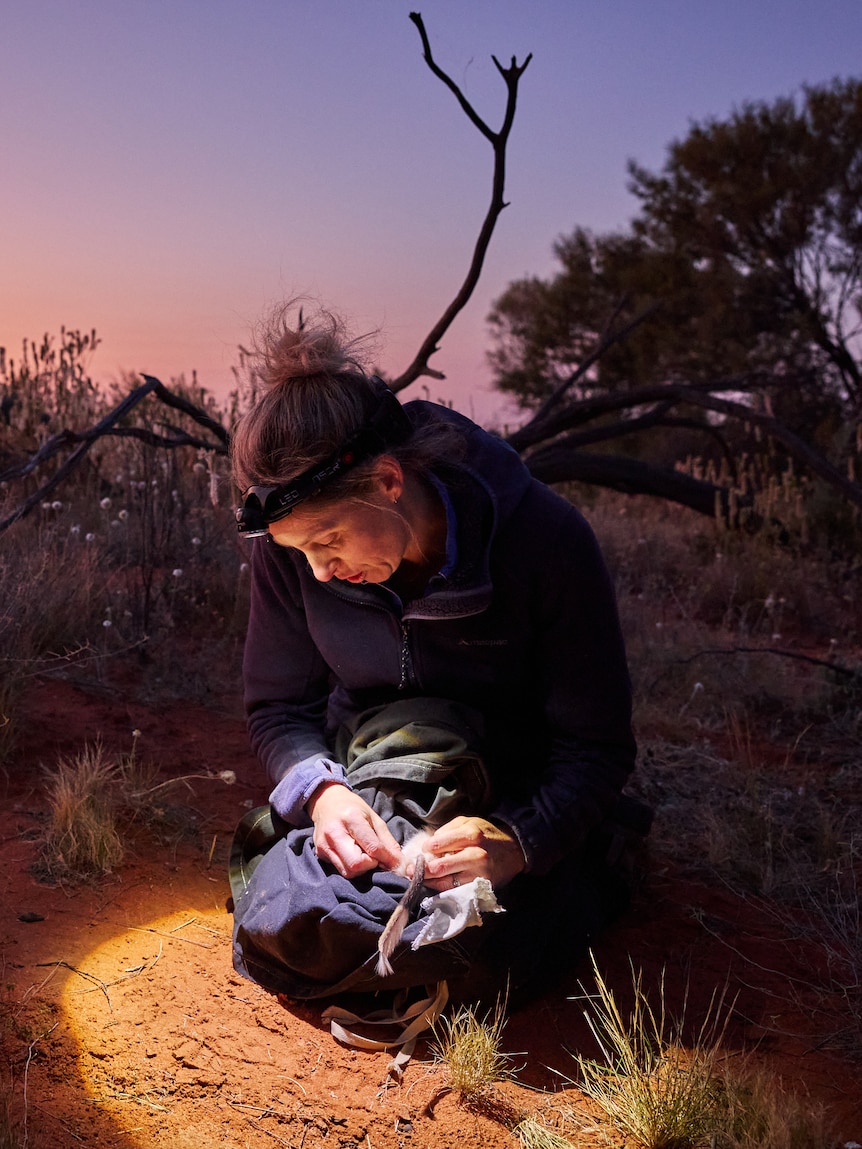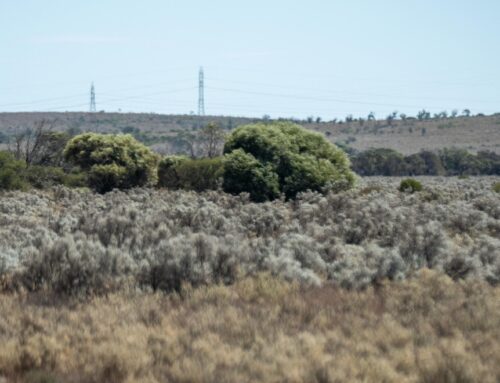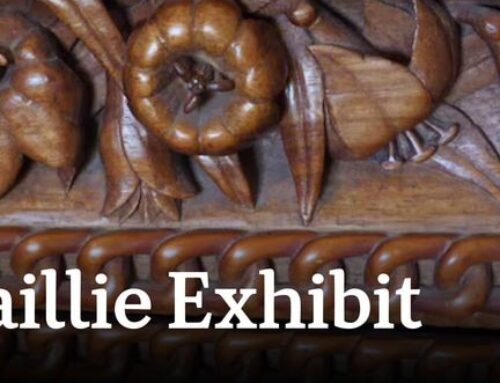Where the dingo fence divides three states, the sun is harsh and wild dust storms are just a gust away, hundreds of new residents are settling into the desert.
But it’s not people who have recently moved to the far north-west corner of New South Wales. Instead, it’s an influx of native animals that have been locally extinct for more than a century.
Bilbies, bandicoots, bettongs and quolls once dominated these arid plains and they are now reclaiming the area, thanks to a team of scientists trying to address Australia’s mammal extinction rate — which is the worst in the world.
“Two-thirds of those losses are due to the predation of cats and foxes, and at the moment there is no long-term solution for the control of cats,” Dave Kelly from the NSW National Parks and Wildlife Service told 7.30.
Feral cats kill more than 1.5 billion native animals every year in Australia.
This is the Wild Deserts project — an ambitious ecosystem restoration plan “trying to return a really large patch of Australia’s arid zone back to how it was before European colonisation”, principal ecologist Rebecca West said.
Threatened species now thriving
Dr West, her husband and three children live on a remote homestead in the Strzelecki Desert, where doing the groceries is a 10-hour return trip.
She’s up before sunrise to check in on 20 research traps laid the day before.
It’s important to check in on these animals in the early hours of the morning because they are all nocturnal and need to be set free before aerial predators go hunting.
7.30 was given rare access to join the team that has been working on this project since 2016.
Inside the first trap is a male golden bandicoot, a threatened marsupial species now thriving in the fenced enclosure set up inside Sturt National Park and designed to keep out feral cats.
Their numbers have ballooned since being reintroduced in mid-2022 from 27 to now more than 400.
“They have incredibly large testes for their small size. Maybe that’s why they’re such good breeders,” Dr West jokes.
About 20 metres down the path is the second trap, where a male burrowing bettong has taken the bait.
Bettongs were only moved here four months ago.
The new resident is weighed and physically examined before it is set free and hops back into its warren.
“Some of the stuff we are looking at is the conditions of the animals and whether they are breeding post-release,” Dr West said.
Restoring the ecosystem
Before scientists reintroduced these animals, they had to ensure these safe havens were free of feral cats, foxes and rabbits, which took years of work.
Once the enclosures were set up, the plan was to release seven mammals back into the Strzelecki Desert, including:
- Bilbies
- Shark Bay bandicoots
- Crest-tailed mulgaras
- Golden bandicoots
- Stick-nest rats
- Burrowing bettongs
- Western quolls
The first animals to be reintroduced were the bilbies, which are considered the “ecosystem engineers”.
“They come in, they dig for their food, they dig for their shelters and they start to turn over the soil and the ecosystem and we’ve seen the benefits of that,” Dr West said.
“We get more plant growth, we get water collecting in those holes and suddenly your ecosystem starts to come to life.”
Soon the other animals followed, with the “final piece to the puzzle” — the western quoll — reintroduced a few months ago.
“It’s the top predator. It’s about getting that food web that was here 100 years ago,” project lead Richard Kingsford said.
“If you have missing layers, certain species can take over the place and eat themselves out of house and home, so it’s really important to reconstruct the whole food chain so that you’ve got a way of having the system much more in balance.”
The cat-sized carnivorous mammals were bred at Taronga Western Plains Zoo after it received approvals to take a small number of them out of the wild in Western Australia.
“Then we do the genetics and we control the breeding so that we have a really good genetic output,” Andrew Elphinstone from Taronga Conservation Society Australia said.
“It’s very hands-off. We want to promote a lot of natural behaviour so the animals are actually fit to survive in the wild.”
Not every animal’s release was successful though, with the stick-nest rat failing to thrive.
“What we think happened was the type of habitat here, even though it used to be here, was just not quite what it was expecting,” Dr Kingsford said.
“You need to learn from those failures. But you know, overwhelmingly, we’ve got this huge success story.”
Native species learning to adapt
Beyond the safe enclosures, the team has created a 100-square-kilometre area it calls the wild training zone, where it allows a very small number of feral cats to roam.
It uses the dingo fence as a “leaky” entrance to help control the number of these invasive predators.
“It allows us to reintroduce some of these threatened species back into this landscape while being able to put our foot, if you like, on the cats and foxes to such a low level that they’re not wiping them out,” Dr Kingsford said.
“And [that] allows some of these animals to get a bit smarter about escaping from these fairly novel predators that they haven’t really adapted to in terms of their evolution.”
Dr West describes it as a “halfway house” that helps train the native animals to avoid predators and develop survival traits to pass on to the next generation.
So far, bilbies and western quolls are roaming the wild training zone and the team is considering moving some golden bandicoots there soon.
The feral cat problem
Keeping predators at bay is a never-ending task. While in the training zone they are controlled, their population outside the zone is 10 times that.
“When you’re managing a feral predator, you need to have a lot of tools in your toolkit,” Dr West said.
Spotlight shooting, trapping and baiting are used to cull cat numbers as well as a device called a Felixer grooming trap.
It uses cameras and sensors to target cats that walk past by spraying a poisonous gel, known as 1080, which lands on the animal.
The feral cat will groom the 1080 off its body, digesting the poison, which then kills it.
1080 has been derived from Australian plants, so native wildlife have a natural tolerance to it, unlike introduced pests.
“We want to see Felixer grooming traps rolled out, we want to investigate how we better use drone technology to identify cats in the landscape, we’re also looking at gene-based technologies to reduce the breeding rates of cats in the future,” Federal Environment Minister Tanya Plibersek said.
“We need to bring science into the way that we’re dealing with feral cats.”
The finalised Feral Cat Threat Abatement Plan is due to be released in the coming months and will set out a national approach for managing the animals.
The end game
The Wild Deserts project is a 10-year partnership between UNSW, Ecological Horizons, Taronga Conservation Society and the NSW National Parks and Wildlife Service.
Its funding ends in 2026, but the team hopes it can continue its work, which may eventually lead to native animals being reintroduced beyond any fences and into the wild.
“We’re going to need this two-way approach where we are continuing to improve our control of feral cats, and we’re also trying to improve the response of our native species so that we can get this coexistence at a big scale,” Dr West said.
“These cats are always going to be in the Australian landscape; what we need to be able to do is basically reduce them so that we can allow wildlife to flourish,” Dr Kingsford said.
“These places used to be absolutely alive, and we see that even now when we come out here to the places where we don’t have cats and foxes, it’s amazing.
“That is the real goal. If we can do that for Australia it would be fantastic.”
Watch 7.30, Mondays to Thursdays at 7:30pm on ABC iview and ABC TV.




